Webfolios may have the most significant effect on education since the introduction of formal schooling. When fully matured and implemented by capable professional educators throughout every discipline in an educational institution, webfolios promise a viable alternative to current, high-stakes testing, which focuses education on test-taking rather than teaching and learning. The promise webfolios hold—a richer educational experience for all—will not be realized, however, unless educators embrace webfolio concepts and apply them at their highest level of maturation. This will take time because institutions and educators must systematically work through five stages before arriving at the point where authentic evidence—such as that provided by fully implemented webfolio systems—replaces high-stakes testing as authoritative evidence for assessment, evaluation, and reporting.
From the earliest days of the Web, we have been involved in collaborative efforts with students, teachers, researchers, and administrators in K–12 schools and tertiary institutions regarding student portfolios on the Web. Over the course of conducting hundreds of workshops and presentations in a variety of professional forums, we have learned that educators involved in efforts to implement Web portfolios often "begin at the end," a recipe for disaster. This compulsion to begin at the end (an unrealistic goal) is often fueled by visits from national or state accreditors who direct institutions to include authentic evidence in their assessment and evaluation reports. Consequently, educational leaders awkwardly turn to Web portfolios in hopes of quickly obtaining authentic data for accreditation reports. "Beginning at the end" fails because the incremental steps for full implementation are missing—like trying to leap from one side of the river to the other.
Implementing webfolios is a complex and difficult leap. The authentic data to be collected, synthesized, and analyzed must come from students, teachers, researchers, and administrators who work collaboratively to enhance teaching and learning through the use of webfolios. Without incremental steps from one side of the river to the other, students and faculty colleagues may be unwilling participants because there is no logical explanation for change and because the ultimate goals are not made clear. Disparate and overly ambitious goals without an incremental plan of action lead to confusion, frustration, and disillusionment.1
Our intent is to develop a taxonomy for "levels of maturation" that serve as metaphorical stepping stones on the course to full implementation of webfolios. Clearly defining each level of maturation, in terms that all can understand, generates transitional metaphors that will enable educators to say, "Our program is at level three," and others will tacitly know where that program resides in its use of portfolios. Then, productive discussions can focus on what helped the program get to level three, whether those involved plan to move to level four, and, if so, what they will do to make that move. The transitional metaphors inherent in this taxonomy will help educational leaders "begin at the beginning" and work towards the end, a recipe for success.
This article will be of interest to anyone concerned about the role and value of portfolios. It will help students, teachers, program administrators, and information-systems personnel understand the potential webfolios hold for improving education. It also illuminates the paradigm shift that occurs when educational institutions make the leap from traditional portfolio assessment to webfolio assessment, evaluation, and reporting. Those engaged in leading educational innovations and change will benefit from the use of the terminology in this article as they work to empower others to understand an institution’s current level of maturation, develop and share a common vision of the level they would like to attain, and chart a course for moving from one level to the next. As a result, the terminology will help inform all who are involved in educational change and teaching and learning.
This article chronicles the journey from paper and e-portfolios to webfolios and defines five levels of maturation. We include a Taxonomy for the Determination of Levels of Maturation, which can be used to ascertain an institution’s current level and can provide a conceptual framework for attaining the highest level the institution desires. Then, with a plan in place, the taxonomy can be used to assess the institution’s progress. The distinction among paper, e-portfolio, and webfolio is critical because only the webfolio will support an institution’s progress through all five levels.
Defining the Levels of Maturation
We determined the five levels of maturation by analyzing and categorizing eight physical and theoretical qualities inherent in the portfolio/webfolio processes and applications:
In addition, we considered six value-oriented issues: value to the student, value to the employer, value to the educator, value to the educational institution, potential for contributing to digital equity2 within the educational institution, and expense involved in developing the portfolio/webfolio.
Applying these criteria to the portfolio/webfolio process and application, we identified five levels of maturation.
- Level 1—Scrapbook
- Level 2—Curriculum Vitae
- Level 3—Curriculum Collaboration Between Student and Faculty
- Level 4—Mentoring Leading to Mastery
- Level 5—Authentic Evidence as the Authoritative Evidence for Assessment, Evaluation, and Reporting
In discussing the levels of maturation, we make a distinction between hard-copy portfolios, e-portfolios, and webfolios. A hard-copy portfolio usually consists of paper artifacts in a binder. An e-portfolio resides on disk, CD-ROM, or similar physical transportable media and is not accessible from the Web. A webfolio resides on the Web and "is a tightly integrated collection of Web-based multimedia documents that [could include] curricular standards, course assignments, student artifacts in response to assignments, and reviewer feedback of students’ work."3 As explained in our detailed definitions of each of the levels, only the webfolio is robust enough to support all five levels. Paper and e-portfolios are inherently limiting.
The Taxonomy for Determination of Level of Maturation
We present the Taxonomy for Determination of Level of Maturation at the outset so the reader will have a graphic organizer for thinking about the detailed descriptions and definitions of the levels. This taxonomy will also help readers ascertain where their institutions are in the maturation process and determine what can be done to get to the next level. Once a current level of process and application has been identified, readers may refer to the descriptions that follow to assemble ideas and plan implementation strategies that lead to the next level. It is important to remember that different programs and educators within the same educational institution can operate at different levels of maturation at the same time.
Figure 1 provides a series of statements that can be used to ascertain an educator’s or an institution’s current level.
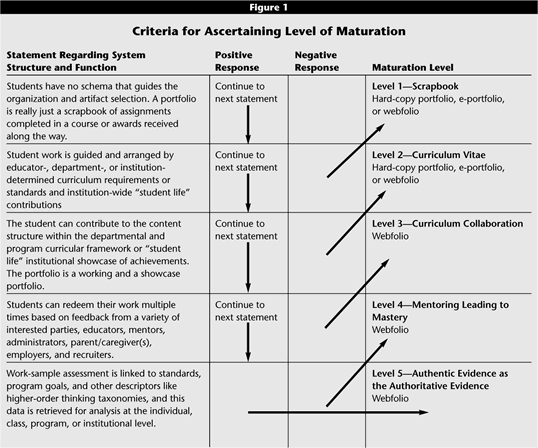
Click image for larger view.
Levels of Maturation
We will explore each level of maturation in order to explain the summary presentation in Figure 1.
Level 1—Scrapbook
At Level 1, students who develop portfolios are really just putting together scrapbooks, and they do this primarily on their own initiative to help them remember where they have been and what they have done. Their portfolios are simply collections of selected assignments completed in a course or awards they received along the way. These students are usually unaware of each other’s scrapbook activities. Most of them produce a new scrapbook for each course or year in the program and have no schema for how to continue building a scrapbook from one experience to the next.
The organization of the student portfolio is chaotic. Portfolios containing work samples from a variety of courses spanning several years are nonexistent or rare at best. If they do exist, the content and format varies considerably from student to student, reflecting the unguided efforts of students working alone. A few students see the scrapbook as a device that may help them get a job, but most place little value on their collection of work.
The feedback students receive on Level 1 portfolios is usually limited to comments and grades displayed on the work samples. When students have an opportunity to share scrapbooks with an interested party, they must deliver the scrapbooks by hand unless they are on the Web; if so, feedback will be asynchronous (by e-mail) at best. Students who share a scrapbook with a prospective employer can usually find time to show them only a few items, and the interested party is usually drawn to the visual elements of the scrapbook, initiating feedback like, "So, you took a course in..."
Student decisions on what to include in a Level 1 portfolio are individual and depend on how the student feels about a particular work sample. There is little deep reflection because decisions to include one item over another are based more on emotion than on informed criteria.
At best, the student provides a time-based context for each item in the scrapbook. The student arranges each item from beginning to end to tell the story of his or her success or growth. Often this chronological arrangement is the only clue the viewer is given about context. The interested viewer can only guess at the meaning of each item.
Other than a collection device, the portfolio may have no other value to the student. If the heuristic process was a rich one, then the value will increase. There is no telling how rich that process has been, however, because the only context interested viewers have is provided by and communicated from the student’s perspective.
The Level 1 portfolio is of little value to the educator and the educational institution. The Level 1 portfolio or scrapbook process does not assure digital equity, and scrapbooks are relatively expensive because they are difficult to maintain, organize, and distribute. Table 1 provides a summary of qualities used to describe portfolios, e-portfolios, and webfolios at Level l.
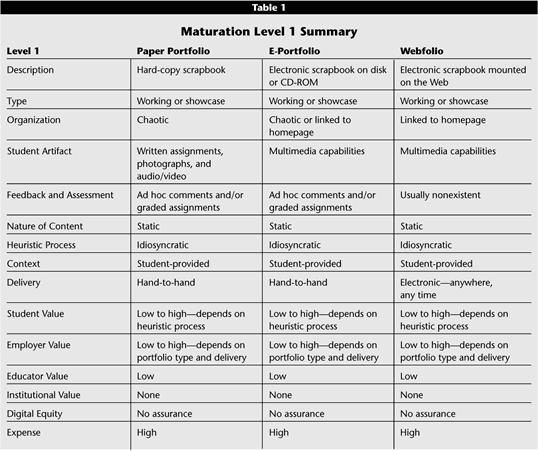
Click image for larger view.
Level 2—Curriculum Vitae
At Level 2, a cadre of educators or the institution itself has identified a curricular framework or template that will help students organize and construct their portfolios. This initiative will range from the few educators who require portfolios to an institution-wide requirement for all students. There is little consistency in student-generated content or format. There is more consistency in purpose. The portfolios are used to supplement promotion materials or to accompany applications for employment. If the portfolio is a showcase-type only, then it is maintained as a paper portfolio or an e-portfolio. Only the webfolio will include the working and the showcase portfolio at Level 2.
The educational authority determines the organization of the Level 2 portfolio, and students merely conform to this organization as a matter of completing the program. Some communication from the educator indicating standards the portfolio must meet usually defines the organization of a Level 2 portfolio. If it is a paper portfolio or an e-portfolio, this is usually communicated on paper or electronic messaging. If it is a Level 2 webfolio, this organization can be communicated by a template or organizational database that facilitates conformity by all students.
Items in a Level 2 portfolio range from scrapbook-type entries to multimedia presentations in the e-portfolio and webfolio versions. As a result, feedback will range from comments and grades on assigned papers to asynchronous comments from educators on the multimedia work samples.
The student’s heuristic process is limited by the template provided by the institution or program. With paper and e-portfolios, deep reflection is possible but not encouraged because there is little feedback on the selection of artifacts or on how those work samples fit with the standards. Webfolios organized in a database allow the student to reflect on each artifact and determine whether it will be a part of a working or showcase portfolio. Feedback from educators is not part of the formal process—the student merely uses the Level 2 portfolio to communicate with prospective employers and as a device to meet all requirements of the program.
While the organization of the Level 2 portfolio does provide some clues about the artifacts, the student—in describing each item and how it meets a standard or program requirement—provides most of the context. Viewers can see that the student has a work sample that meets each standard or program requirement, but they have no clue why the standard or program requirement is important to the educational institution.
Level 2 paper and e-portfolios must be hand-delivered; the webfolio enjoys the ability to be electronically transmitted any time and anywhere.
The value to employers and students is high. Essentially, students are communicating enhanced curriculum vitae that provide evidence of having met institutional standards or program requirements. The heuristic process of developing such curriculum vitae enhances students’ understanding of the total program and better enables them to provide assurances to employers that they are truly qualified to do a particular job.
The value to educators is moderate. They will instantly be able to see whether students can generate work samples that address institutional standards or program requirements. At Level 2, educators do not provide formative feedback, so the feedback given to students is generally summative in nature and determines whether students will graduate from the program or institution. As a result of the summative assessment of student work, educators receive some feedback on their teaching and on the program’s effect on students.
Level 2 portfolios are of low value to the educational institution. Paper or e-portfolio versions of Level 2 portfolios do not assure digital equity. A Level 2 webfolio allows the institution to ensure that all students have equitable access to communication and information resources and to the learning opportunities provided by the webfolio system. Paper and e-portfolio versions of Level 2 portfolios are relatively expensive and difficult to maintain and organize, and students must develop new ones each time they are updated. The Level 2 webfolio’s expense is low because students can assign and reassign access to a variety of constituencies; because students can modify webfolio items, which are instantly updated for all to see; and because there is no delivery cost to the student. Table 2 provides a summary of qualities used to describe portfolios, e-portfolios, and webfolios at Level 2.
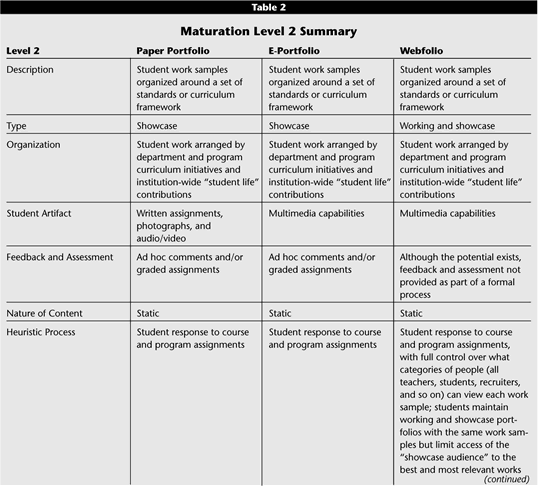
Click image for larger view.
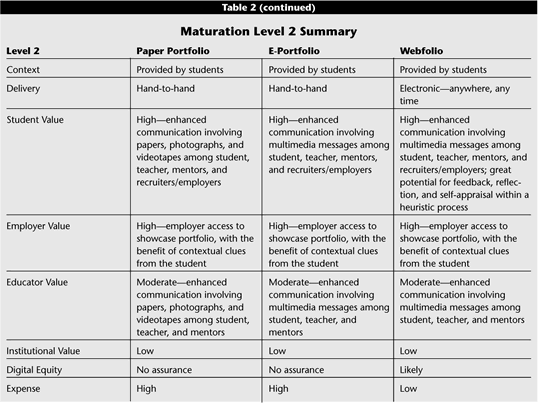
Click image for larger view.
Level 3—Curriculum Collaboration Between Student and Faculty
Above Level 2, paper and e-portfolios do not exist (this is reflected in Tables 3–5). Paper and e-portfolios do not have the functionality to link formative and summative feedback to specific multimedia student work samples, which is a primary characteristic of Level 3. Also characteristic of Level 3 is the organization by curricular requirements and electives or by standards established by a cadre of educators or the institution itself.
Items in Level 3 webfolios can be part of either a working or a showcase webfolio; the student makes this determination. Work samples are arranged in a database according to a curricular framework and/or program standards, but the student can select who can view which item(s) in the webfolio. As a result, the student nominates who can provide formative and summative feedback for each webfolio item. This designation is part of the heuristic process in which students not only determine which work samples will be placed in working and showcase webfolios but also select what types of people (such as their instructor, all instructors, or all instructors and mentors) can view and comment on their work.
The context for Level 3 webfolios is rich with input from educators, students, and the institution itself. Educators provide context by adding syllabi or units of work to the webfolio system. These resources are available to registered students and to employers who have access to the student’s showcase portfolio. Built into the syllabus is information about the institution, often in the form of a link to the institution’s Web site. Educators also provide context by supplying information about each required item. They provide assignments, information about help with those assignments, resources that will assist students completing the assignments, and information about how the assignments will be assessed. This information is viewable by employers, too, if the student allows them access to his or her work. Students also provide context for their work as they respond to assignments in the webfolio system.
Access to webfolios for educators, mentors, or employers is instantaneous when permission is granted. Prospective employers can view a webfolio when they receive an e-mail with information on how to access the student’s webfolio, such as logon details or a URL. Employers will see the student’s work samples and the context of the work—assignments and the syllabus or unit of work associated with the webfolio—but not educator and mentor comments.
The value of a Level 3 webfolio is high for students, educators, and employers. The faculty-student curriculum collaboration built into the Level 3 webfolio enhances communication between students and educators, allows for flexibility in delivery of the curriculum, and, enhances the chances for student success. The educator also benefits from the ability to repeat instructional implementation by copying course content from one semester to the next, each time enriching the content through additional resources and new curricular initiatives. Employers can view the student’s showcase portfolio, including contextual clues from the institution, syllabi, assignments, help, resources, and assessment criteria. The value to the institution is moderate because it indirectly benefits from the educator’s ability to repeat instructional implementation by copying course syllabi from one instructor to the next.
At Level 3, there is a high probability of digital equity because the institution will ensure that every student has equitable access to communication and information resources and to the learning opportunities provided by the system. Expense of the Level 3 webfolio is low because students can assign and reassign access to a variety of constituencies; because students can modify webfolio items, which are instantly updated for all to see; and because there is no delivery cost to the student. Table 3 provides a summary of qualities used to describe webfolios at Level 3.
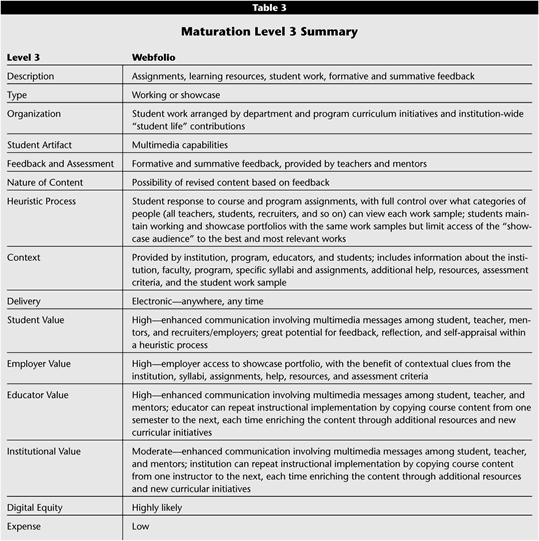
Click image for larger view.
Level 4—Mentoring Leading to Mastery
Level 4 webfolios are organized by curricular requirements and electives or standards established by a cadre of educators or the institution, but they also let students generate portals for displaying work samples and achievements within the same curricular structure or institutional standard. Level 4 webfolios allow multiple opportunities for students to receive feedback from mentors and educators and to redeem their work. This redemption of their work is more than a simple revision to meet minimum standards or to "please the professor." In redeeming their work, students strive to maximize their potential by taking advantage of mentoring and multiple opportunities to gain intellectual insight and to demonstrate mastery of standards and of program goals. At the end of a period of time—generally the length of the unit of study—the educator can "lock out" students from making further alterations to their work samples, allowing educators to make summative judgments about the work samples and ensure that the summative assessment is linked to the samples.
Work samples and achievements can either be part of working or showcase webfolios. Students will nominate who can view and provide formative and summative feedback for each item in their webfolios. This designation is part of the heuristic process in which students not only determine which work samples will be placed in working and showcase webfolios but also select what types of people (such as their instructor, all instructors, or all instructors and mentors) can view and comment on their work. Additional heuristic value comes from the student’s ability to generate her or his own portals for displaying work samples and achievements. The student then not only determines the item of value but also is able to place it in a curricular context and describe the item to others who have access to view and/or comment on the item.
The Level 4 context is even richer than preceding levels because it includes descriptions from educators, students, and the institution and from student-generated webfolio items. Again, educators display their syllabi or units of work with links to the institution Web site. Educators also provide information about each required item. Level 4 webfolios provide the assignment, helping information, resources that will assist students completing the assignment, and information about how the assignment will be assessed. When a student generates a portal for a webfolio item, he or she adds a description of the item to be placed in the webfolio. This contextual information is all viewable by employers if the student allows them access to the item.
Access to a webfolio is instantaneous when the student gives permission to registered users to access work samples and achievements. Prospective employers can view webfolios online, as well as assignments, student-generated descriptions, syllabi, and units of work associated with the webfolio.
The Level 4 webfolio is of high value for students, educators, and employers. The mentoring built into the Level 4 webfolio enables students to work toward mastery of each teaching and learning assignment and to display achievements within a curricular context. The enhanced communication between students and educators not only allows for flexibility in delivery of the curriculum—enhancing the chances for student success—but students can also redeem their work after receiving feedback from educators and mentors on responses to a given assignment.
The educator benefits greatly from the ability to repeat and enhance instructional implementation by copying course syllabi and assignments from one semester to the next, each time enriching the content through additional resources and new curricular initiatives. Employers view the student’s showcase webfolio, with the benefit of contextual clues from the institution, syllabi, assignments, help, resources, assessment criteria, and student-generated descriptions of achievements. The value to the institution is moderate, as the institution indirectly benefits from the educator’s ability to repeat instructional implementation by copying course syllabi from one instructor to the next.
At Level 4, there is a high probability of digital equity because the institution will ensure that every student has equitable access to communication and information resources and to the learning opportunities provided by the system. Expense of the Level 4 webfolio is low because students can assign and reassign access to a variety of constituencies; because students can modify webfolio items, which are instantly updated for all to see; and because there is no delivery cost to the student. Table 4 provides a summary of qualities used to describe webfolios at Level 4.
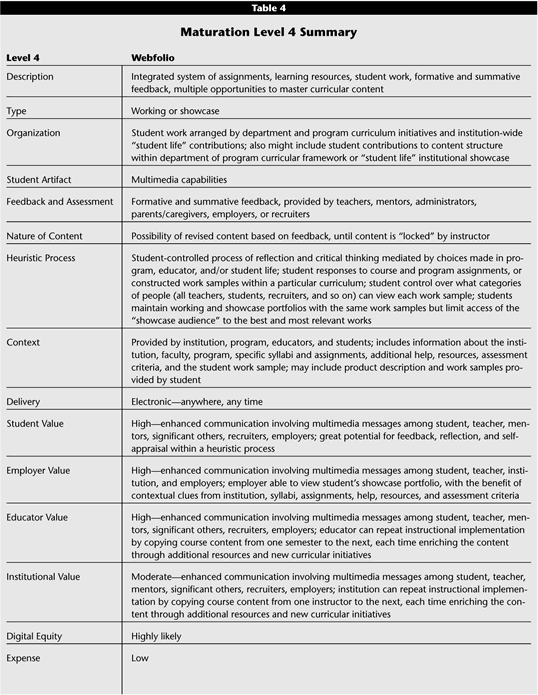
Click image for larger view.
Level 5—Authentic Evidence as Authoritative Evidence for Assessment, Evaluation, and Reporting
At Level 5, webfolios are organized by curricular requirements and electives or by standards established by a cadre of educators or the institution. Students generate portals for displaying work samples and achievements within the same curricular structure or institutional standard. In addition, educators link standards, departmental goals, and other descriptors—such as higher-order thinking taxonomies—to specific webfolio items, including student-generated work samples and achievements. Level 5 webfolios allow multiple opportunities for students to receive feedback from mentors and educators and to redeem their work. At the end of a period of time—generally the length of the unit of study—the educator can "lock out" students from making further alterations to their work samples and assign a summative assessment to their work.
Work samples and achievements can either be part of working or showcase webfolios. Students will nominate who can view and provide formative and summative feedback for each item in their webfolios. This designation is part of the heuristic process in which students not only determine which work samples will be placed in working and showcase webfolios but also select what types of people (such as their instructor, all instructors, or all instructors and mentors) can view and comment on their work. Additional heuristic value comes from the student’s ability to generate her or his own portals for displaying work samples and achievements. The student then not only determines the item of value but also is able to place it in a curricular context and describe the item to others who are then given access to view and/or comment on the item. In addition, educators can assign standards, departmental goals, and other descriptors—such as higher-order thinking taxonomies—to the student-generated work samples and achievements.
Access to webfolios is instantaneous when students give permission to users to view work samples and achievements. Prospective employers can view webfolios online, as well as assignments, student-generated descriptions, syllabi, and units of work associated with the webfolio.
The Level 5 webfolio is of high value for students, educators, and employers. It enables students to work toward mastery of each teaching and learning assignment and to display achievements in a curricular context. The enhanced communication between students and educators not only allows for flexibility in delivery of the curriculum, enhancing the chances for student success, but also allows students to redeem their work based on feedback from educators and mentors on each response to a given assignment.
The value to educators is high because they can repeat and enhance instructional implementation by copying course syllabi and assignments—complete with links to standards, departmental goals, and other taxonomies such as higher-order thinking—from one semester to the next, each time enriching the content through additional resources and new curricular initiatives. Educators can also ascertain which students met or exceeded standards linked to specific assignments. As a result, educators can use the assessment data generated within the webfolio system each semester to assist with course revision. The value to employers is high because they can view showcase portfolios, with the benefit of contextual clues from the institution, syllabi, assignments, help, resources, assessment criteria, and student-generated descriptions of achievements.
The value to the institution is high because of enhanced communication involving multimedia messages among student, teacher, mentors, and significant others, such as recruiters and employers. The institution benefits from the ability to repeat instructional implementation by copying course content—complete with links to standards, departmental goals, and other taxonomies such as higher-order thinking—from one instructor to others, each time enriching the content through additional resources and new curricular initiatives. The institution can also ascertain which students met or exceeded standards linked to specific work samples and achievements. The institution can use the assessment data generated from the webfolio system each semester to assist with program assessment and revision.
At Level 5, there is a high probability of digital equity because the institution will ensure that every student has equitable access to communication and information resources and to the learning opportunities provided by the system. Expense of the Level 5 webfolio is low because students can assign and reassign access to a variety of constituencies; because students can modify webfolio items, which are instantly updated for all to see; and because there is no delivery cost to the student. Table 5 provides a summary of qualities used to describe webfolios at Level 5.
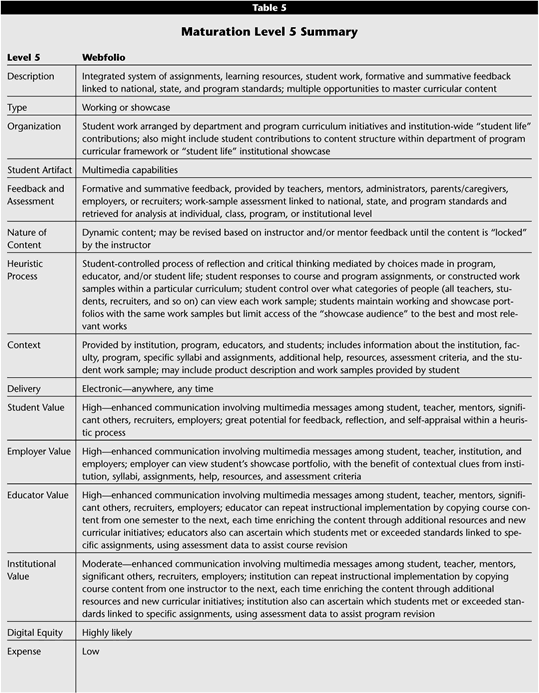
Click image for larger view.
Two Portfolio Journeys
Two case studies offer useful insights into how two institutions approached and handled the move through several levels of webfolio maturation. Sample portfolios resulting from these journeys may be viewed on the Web at <http://www.folioworld.com/examplewebfolios.htm>.
California Lutheran University, School of Education
In 1997, California Lutheran University’s School of Education used portfolio assessment throughout the teacher education program. Students’ portfolios were displayed in binders, and at times the hallways of the education building were lined with neatly stacked portfolios. Occasionally, portfolios were misplaced or even lost as faculty passed them around for comment and assessment. At that time, portfolios ranged from Level 1 portfolios—mainly generated in the capstone liberal studies course—to Level 2 portfolios, in which students demonstrated competencies that met state standards for the teaching profession.
That year, the Curriculum and Instruction (CandI) program in the School of Education was the first to begin using the ProfPort webfolio system. Initial use of the webfolio system was at Level 2. It was envisaged that webfolios would be used simply to house student papers and other artifacts generated in response to course assignments.
In 1999, the School of Education was awarded a federal grant, "Preparing Tomorrow’s Teachers to Use Technology," one of the goals of which was to develop and implement an institution-wide electronic portfolio system that would eliminate the hard-copy binders. At the same time, professors began using the webfolio system in their courses. This led to the use of the webfolio system at Level 3. Faculty began to display their syllabi and course assignments in the system, and students responded to the assignments by placing their papers, projects, and presentations in the system. As students prepared their responses, they often found useful resources, and faculty added these newfound resources to the webfolio system. As soon as faculty updated their courses in the system with the new resources, all students in their class had access to those resources through the webfolio system, enriching the course offerings over time.
In 2000, the teacher preparation program began using the webfolio system at Level 4. Students used the webfolio system to display artifacts that showed they had met state standards for the teaching profession. Faculty, supervisors, and cooperating teachers then used the system to provide students with feedback regarding their work. As a result of this feedback, students were able to redeem their work and again seek feedback from their mentors.
At the same time, the CandI program instituted a portfolio defense in which master’s degree candidates developed showcase portfolios demonstrating they had met all seven goals of the program. A panel of adjudicators reviewed and assessed each candidate’s showcase portfolio, providing reflective feedback that helped shape the candidate’s defense. Then, as a culmination of their work in the CandI program, the master’s candidates presented their showcase portfolios in an oral defense to their panel of adjudicators. At the end of the oral defense the adjudicators voted to pass or fail the candidate.
In 2004, all programs in the School of Education will use the ProfPort webfolio system. The CandI, teacher preparation, and special education programs will use the system at Level 5. In these programs, both the program competencies and course assignments will be linked to state standards and program goals. Student work addressing competencies and assignments will be assessed by faculty, supervisors, and cooperating teachers. At the end of each semester, student assessments—linked to program goals and standards—will be downloaded from the webfolio system and analyzed to ascertain the effectiveness of the instruction and the program. The data will also be used to determine how well students are meeting state standards and the goals of the programs. These data will be synthesized and used to report information about students and each program.
Illinois State University, Business Information Systems Program, College of Business
In the fall of 1994, freshman and sophomore students enrolled in a core introduction to business information systems course at Illinois State University’s College of Business were required to create Web home pages. The assignment had technical requirements (hyperlinks, images, and dividers), but little in the way of subject or content guidance. A few students focused their home page on academic achievements and materials to support internships and job searches. Others focused on hobbies, pets, sports, and other nonacademic topics. Those students who focused on academics for the project had created Level 1 portfolios, and the portfolio journey had begun.
Prior to the start of the 1995 spring semester, Business Information Systems (BIS) faculty joined with other Department of Accounting faculty to identify possible grant topics. The use of paper student portfolios to assist with career development and job searches was one topic that received support for further exploration. Faculty wanted to help students increase their awareness of professional opportunities and their understanding of the connections among career planning, student life, and formal course work.
Faculty that had assigned the home page in the information systems course believed the proposed portfolio concept could dramatically enhance the value of the assignment by providing much-needed structure. Development was proposed of a computer system that would help students build portfolios on the Web and allow faculty, mentors, and recruiters access. The proposed system required interaction with a database to dynamically create portfolio pages on the Web. As the system was being built, a few faculty members developed a portfolio structure that included formal competencies, student life activities, and career planning as major portfolio sections, with each having subsections that provided guidance to students. This structure moved participants to Level 2. The system’s use of a database that provided dynamic portfolio content and advanced search capabilities represented the beginning of webfolios for the BIS program at Illinois State University.
In 1997, the system was completely rewritten, taking advantage of new technology. The new system allowed students to control access to individual parts of their portfolios by assigning viewing rights to the following groups of users: faculty, mentors, recruiters, other students, and all Internet users. In addition, for each assignment, standard, or competency in the portfolio, faculty could provide assignment, help, Internet resources, and assessment rubrics.
In this version, each student could add to his or her portfolio’s table of contents by adding courses. The activities and assignments associated with each course also became part of the portfolio’s table of contents. In addition, this mechanism was used to add portfolio sections that were not formal courses. For example, a student could add "community service," with associated subsections, to a portfolio. In this way students could contribute to the portfolio structure, although this contribution required action on the part of faculty. When one of these new "courses" was created at the request of an individual student, it could be added as needed by other students to their portfolios.
Several mechanisms were available for providing feedback. Some faculty opted for the traditional approach of writing in the margins of pages printed from the Web, but new ways were also adopted. For example, on assignment due dates, some instructors examined completed work in student portfolios just before the start of class. As they worked their way through portfolios, they put together a list of student presenters and the aspects of the assignment to be presented. When class started, instructors identified students who were to present particular sections of their portfolios and indicated which aspect(s) of the assignment the students should address. Students in the class were encouraged to comment; instructors combined student comments with their own in a summary that benefited all students in attendance.
During the 1998–1999 academic year, the system was modified to include a comment log for faculty and mentors to enter comments on portfolio work samples for each student. Students’ ability to determine the portfolio table of contents, and the use of feedback mechanisms including the comment log, marked entry into Level 3.
In 2002, the system was rewritten again using new technologies. The revised system allowed linking assignments, work samples, and assessment to state standards and program goals. The system was ready to support Level 5.
Today, BIS faculty use a collaborative process to identify competencies for each of the department’s courses and to map each of the competencies to assignment/learning activities. Assessment rubrics have been developed for the activities, and assessment scores and additional feedback are provided to students in the comment log. Some faculty allow the opportunity for students to use the feedback to redeem their work on multiple occasions, while other faculty lock students’ work samples from further changes after the first assessment. Students can create their own tables of contents without faculty action. A BIS program assessment process under development will assess competency sequencing in the curriculum and student mastery of the competencies. The BIS program is progressing from Level 3 to Level 4, and the program assessment process under development will move the program to Level 5.
In an interesting twist on this journey, students now have the ability to create e-portfolios from their webfolios. Students can export webfolios to business card–sized CDs that can be passed out to recruiters or others. A student selects the work samples to include, and these work samples, along with the underlying assignment or activity description, are automatically organized and written to a CD. Once saved to a CD, the e-portfolio content cannot be changed, but its table of contents includes a link to the online webfolio. The holder of the CD can click a link to view the student’s current webfolio. Of course, students can also give recruiters or anyone else the URLs for their webfolios.
Conclusion
We considered eight physical and theoretical qualities inherent in portfolio/webfolio processes and applications to determine five levels of maturation.
- Level 1—Scrapbook
- Level 2—Curriculum Vitae
- Level 3—Curriculum Collaboration Between Student and Faculty
- Level 4—Mentoring Leading to Mastery
- Level 5—Authentic Evidence as the Authoritative Evidence for Assessment, Evaluation, and Reporting
The levels of maturation for portfolios/webfolios provide a conceptual framework for understanding webfolios and help readers position themselves in a particular level of webfolio development. The levels also provide conceptual guidance for taking the next step on the path to full implementation of webfolios in teaching and learning. Concomitantly, knowledge of the five levels provides educators with a vocabulary for developing a shared vision for webfolio implementation and presents them with a way of measuring progress towards that vision.
Acknowledgment of differences in the capabilities of alternative portfolio media is critical. Paper portfolios and e-portfolios have inherent limitations that allow them to support only the first two levels of maturation, while a webfolio system can be robust enough to support all five levels.
This article builds on a previous EDUCAUSE Quarterly article4 in which we identified critical success factors for implementing webfolios. The current article provides a taxonomy that provides stepping stones on the course to implementation of webfolios in teaching and learning. A third article (in review) shows how webfolios can challenge the mystique and authority of standardized tests as the guiding force behind education.
As educators systematically work through these five levels, eventually arriving at a point where the use of authentic evidence as authoritative evidence is preferred to traditional, high-stakes testing, they may find they are involved in one of the greatest revolutions in educational thinking since the commencement of formal schooling.
